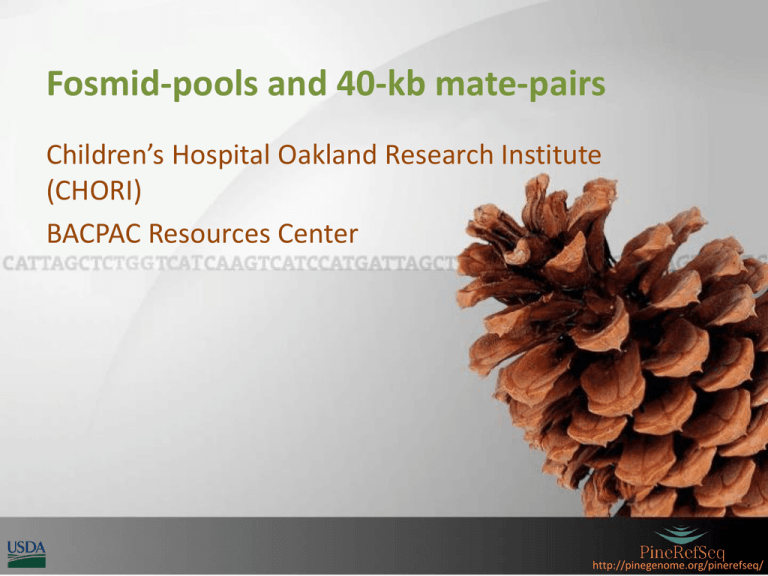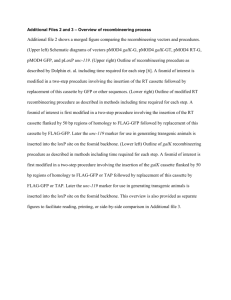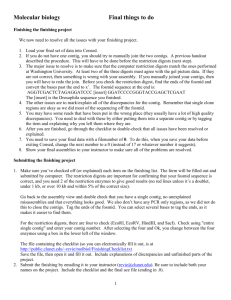
Fosmid-pools and 40-kb mate-pairs
Children’s Hospital Oakland Research Institute
(CHORI)
BACPAC Resources Center
http://pinegenome.org/pinerefseq/
Strategies for Sequencing large genomes
with high-repeat content
A. Scaffolding of contigs (produced by WGS or
Pool Seq strategy) with an abundant source
of long-range (~40 kb) mate-pairs.
B. Reduced complexity: NextGen sequencing
from E.coli clone pools with combined inserts
sizes far below genome size. Creates contigs
limited to the size of clones.
http://pinegenome.org/pinerefseq/
Vector to create 40-kbp mate pair libraries
(“diTags”)
• Cloning of sheared
genomic DNA in bluntended SnaBI site
• Includes options for
creating mate-pairs by 5
strategies:
• Nicking, Nick translation,
S1-nuclease (Nb.BbvCI or
Nt.BspQI nicking sites)
• Fragment insert DNA
with FspBI, Csp6I or both
http://pinegenome.org/pinerefseq/
Fragmenting fosmid inserts:
nicking enzyme approach
• Nicking of vector
(and insert)
• Nick-translate
from vector into
insert
• Convert nick
into break
• Isolate vector
plus attached
insert-ends
• Ligate
• PCT amplify
• Illumina
Sequence
http://pinegenome.org/pinerefseq/
Fragmenting fosmid inserts:
use of 4-cutters
• Digest with
4-cutter
• Isolate
vector with
attached
insert-ends
• Ligate
• PCR-Amplify
• Illumina
Sequence
http://pinegenome.org/pinerefseq/
Fragmenting fosmid inserts:
use of FspBI, Csp6I or together
http://pinegenome.org/pinerefseq/
Reduced Complexity from E.coli clone pools
• Used by others to improve assemblies
• Used also to derive long-haplotype
information
• Ideally: larger clones (BACs) are more
desirable, more likely to span long “duplicons”
• Economically: much cheaper to create large
fosmid libraries using sheared DNA (more
random) with high genomic representation
http://pinegenome.org/pinerefseq/
Fosmid Pools
•
•
•
•
•
•
•
•
•
DNA extraction
Shearing (to average ~40 kbp)
Size-purification (pulsed-field gel
electrophoresis)
Ligation to excess vector
(dephosphorylated ends)
Packaging (extracts from mcrA, B, C
strains)
Determine titer of the “particle
library”
Create E.coli colonies (e.g. 1,000/150
mm Petri dish)
Isolate DNA from colonies and create
Illumina seq libraries
Quality Assessment: Quantitation &
Q-PCR (TAQMAN assays) to
determine E.coli & fosmid vector
contamination
Fosmid colonies:
Documented & counted
prior to pooling
Fosmid pools: DNA
digested (PI-SceI); Lane 6:
Undigested pool
http://pinegenome.org/pinerefseq/
DNA Isolation from fosmid Pools
Criteria:
Options:
•
•
•
•
Scalable?
Representative?
Artifact levels (e.g. chimeric reads? )
Costs?
• Midi-prep columns: high quality/quantity/cost
• Small prep’s followed by amplification (Rolling
Circle Amplification, RCA)
• Crude bacterial lysates purified using biotinlabeled Triple-Helix probes (magnetic beads)
• Triple-helix followed RCA
http://pinegenome.org/pinerefseq/
Triple_Helix Purification of fosmid inserts*
• Removal of vector &
E.coli contamination
• Scalable
• Simple Purification
* Rapid isolation of cosmid insert DNA by triple-helix-mediated affinity capture.
Ji H, Smith LM, Guilfoyle RA. Genet Anal Tech Appl. 1994;11(2):43-7.
* Rapid restriction mapping of cosmids by sequence-specific triple-helix-mediated
affinity capture. Ji H, Francisco T, Smith LM, Guilfoyle RA. Genomics. 1996 Jan 15;31(2):185-92.
http://pinegenome.org/pinerefseq/
Results
•
•
•
•
Newest vector now
in production:
pFOSTH1.0
Pools generated
from midi-prep
DNA, 12 pools
sequenced
Pools generated
from mini-prep &
RCA (enriched for
E.coli mobile
element: IS150)
Pools now being
generated with
pFOSTH1.0
Fosmid pools in pFOSTH1.0 vector :
PI-SceI -digested ; Lane 6: no digest
http://pinegenome.org/pinerefseq/
Acknowledgments
(l to r) Co-PD Pieter de Jong, Ann HoltzMorris, Maxim Koriabine, Boudewijn ten
Hallers
• Work at CHORI by Ann HoltzMorris, Maxim Koriabine,
Ph.D., and Boudewijn ten
Hallers
• Loblolly DNA provided by Dana
Nelson, Southern Institute of
Forest Genetics
• Many collaborators within
Loblolly Pine consortium
• PI: David Neale, UC Davis
http://pinegenome.org/pinerefseq/










